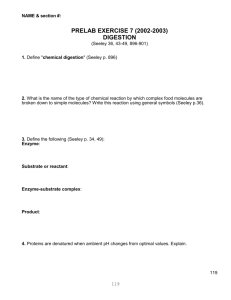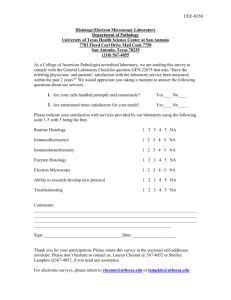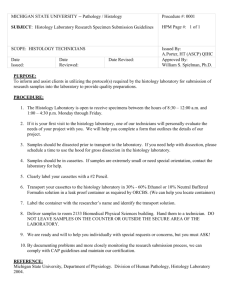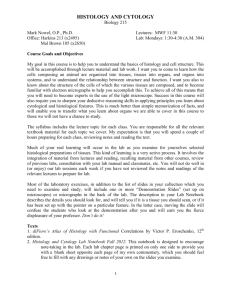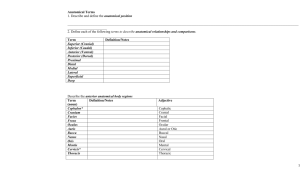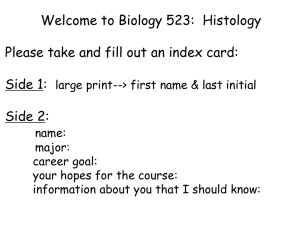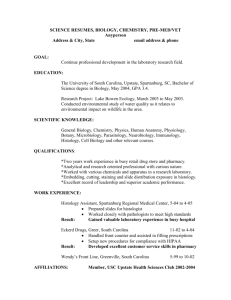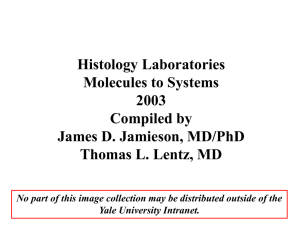Chapter 04 Tissues
advertisement
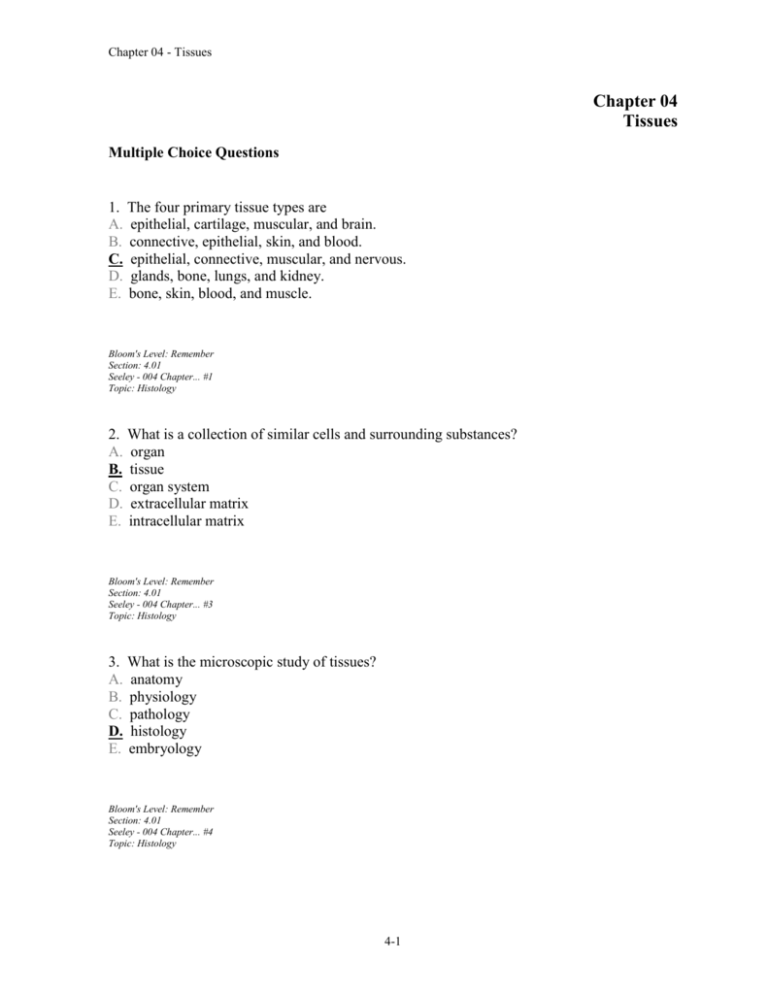
Chapter 04 - Tissues Chapter 04 Tissues Multiple Choice Questions 1. The four primary tissue types are A. epithelial, cartilage, muscular, and brain. B. connective, epithelial, skin, and blood. C. epithelial, connective, muscular, and nervous. D. glands, bone, lungs, and kidney. E. bone, skin, blood, and muscle. Bloom's Level: Remember Section: 4.01 Seeley - 004 Chapter... #1 Topic: Histology 2. What is a collection of similar cells and surrounding substances? A. organ B. tissue C. organ system D. extracellular matrix E. intracellular matrix Bloom's Level: Remember Section: 4.01 Seeley - 004 Chapter... #3 Topic: Histology 3. What is the microscopic study of tissues? A. anatomy B. physiology C. pathology D. histology E. embryology Bloom's Level: Remember Section: 4.01 Seeley - 004 Chapter... #4 Topic: Histology 4-1 Chapter 04 - Tissues 4. The embryonic germ layer that is the source of connective tissue and muscle is A. mesoderm. B. endoderm. C. ectoderm. D. exoderm. E. neuroectoderm. Bloom's Level: Remember Section: 4.02 Seeley - 004 Chapter... #2 Topic: Histology 5. The extracellular material found in tissues is called A. plasma. B. lymph. C. matrix. D. fibroblast. E. cytoplasm. Bloom's Level: Remember Section: 4.01 Seeley - 004 Chapter... #5 Topic: Histology 6. What is the examination of a dead body to determine the cause of death or to study the changes caused by a disease? A. autopsy B. biopsy C. histology D. embryology E. All of these answers are correct. Bloom's Level: Remember Section: 4.01 Seeley - 004 Chapter... #7 Topic: Histology 4-2 Chapter 04 - Tissues 7. What is the removal of a tissue sample from patients via surgery or needle to diagnose disease? A. autopsy B. biopsy C. histology D. postmortem exam E. All of these answers are correct. Bloom's Level: Remember Section: 4.01 Seeley - 004 Chapter... #6 Topic: Histology 8. Which of the following pairs is mismatched? A. endoderm - bone B. mesoderm - muscle C. ectoderm - skin D. neuroectoderm - nervous system E. neural crest cells - peripheral nervous system, skin pigment, tissues of the face Bloom's Level: Understand Section: 4.02 Seeley - 004 Chapter... #8 Topic: Histology 9. Epithelial tissue is characterized by A. tightly packed cells. B. absence of any basement membrane. C. extensive extracellular matrix. D. a rich blood supply. E. both tightly packed cells and a rich blood supply. Bloom's Level: Remember Section: 4.03 Seeley - 004 Chapter... #9 Topic: Histology 4-3 Chapter 04 - Tissues 10. Epithelial tissue is distinguished from connective, muscular, or nervous tissue by its A. extracellular matrix. B. contractility. C. ability to carry action potentials. D. ability to serve as insulation. E. basement membrane. Bloom's Level: Remember Section: 4.03 Seeley - 004 Chapter... #10 Topic: Histology 11. Which of the following is a function of epithelial tissue? A. conduction of action potentials B. secretion and absorption of molecules C. support of other tissue types D. contraction E. shock absorption Bloom's Level: Remember Section: 4.03 Seeley - 004 Chapter... #11 Topic: Histology 12. Which of the following characteristics is NOT consistent with simple squamous epithelial tissue? A. little extracellular material B. rest on a basement membrane C. has good blood supply within it D. the cells are thin and flat (not thick) E. acts as a permeability barrier Bloom's Level: Understand Section: 4.03 Seeley - 004 Chapter... #12 Topic: Histology 4-4 Chapter 04 - Tissues 13. The various types of epithelium are classified by A. the size and shape of cells. B. the shape of cells and number of cell layers. C. the number of cell layers and size of the cells. D. the size and location of cells. E. function and size of cells. Bloom's Level: Remember Section: 4.03 Seeley - 004 Chapter... #13 Topic: Histology 14. Which of the following categories of epithelium is based on cell shape? A. columnar B. keratinized C. stratified D. transitional E. simple Bloom's Level: Remember Section: 4.03 Seeley - 004 Chapter... #14 Topic: Histology 15. Stratified epithelium consists of A. multiple layers of cells. B. a single layer of cells. C. a single layer of cells that changes shape when the tissue is stretched. D. a multiple layer of cells that appears to change shape when the tissue is stretched. E. None of these choices are correct. Bloom's Level: Remember Section: 4.03 Seeley - 004 Chapter... #15 Topic: Histology 4-5 Chapter 04 - Tissues 16. Which type of epithelium has the following characteristics: multiple layers, squamous cell shape, dead outer layers of cells, and keratin present in some cells? A. pseudostratified keratinized squamous epithelium B. simple cuboidal epithelium C. simple transitional epithelium D. moist stratified squamous epithelium E. stratified keratinized squamous epithelium Bloom's Level: Understand Section: 4.03 Seeley - 004 Chapter... #16 Topic: Histology 17. The epidermis of the skin is composed of A. stratified cuboidal epithelium. B. simple squamous epithelium. C. stratified squamous epithelium. D. irregular dense fibrous connective tissue. E. stratified columnar epithelium. Bloom's Level: Remember Section: 4.03 Seeley - 004 Chapter... #17 Topic: Histology 18. To determine that a type of epithelium is squamous, which of the following is most important? A. the number of cell layers B. the shape of most of the epithelial cells C. the shape of the most superficial epithelial cells D. the shape of the basal epithelial cells E. the shape of the basement membrane Bloom's Level: Understand Section: 4.03 Seeley - 004 Chapter... #18 Topic: Histology 4-6 Chapter 04 - Tissues 19. Which of the following cell organelles would be most important in secretory epithelial cells? A. cilia B. Golgi apparatus C. lysosomes D. desmosomes E. microtubules Bloom's Level: Understand Section: 4.03 Seeley - 004 Chapter... #19 Topic: Histology 20. Which of the following epithelial types is mismatched with its function? A. simple epithelium - diffusion B. stratified epithelium - protection C. squamous epithelium - stretching D. cuboidal epithelium - absorption E. columnar epithelium - secretion Bloom's Level: Understand Section: 4.03 Seeley - 004 Chapter... #20 Topic: Histology 21. Which of the following statements is false? A. Secretory epithelial cells are usually cuboidal or columnar in shape. B. The movement of materials through epithelium is enhanced by simple squamous epithelium. C. Stratified epithelium is adapted for a protective role. D. Columnar epithelial cells promote diffusion. E. Cuboidal epithelium is found in areas where absorption occurs. Bloom's Level: Understand Section: 4.03 Seeley - 004 Chapter... #21 Topic: Histology 4-7 Chapter 04 - Tissues 22. Epithelium that is primarily secretory in function would most likely be A. simple squamous. B. stratified squamous. C. keratinized columnar. D. transitional. E. simple cuboidal. Bloom's Level: Understand Section: 4.03 Seeley - 004 Chapter... #22 Topic: Histology 23. Which of the following statements concerning epithelial cell surfaces is false? A. Smooth surfaces reduce friction. B. Epithelium with folded surfaces tends to be very rigid. C. Cilia propel materials along the surface of an epithelial cell. D. Epithelial cells with microvilli are involved in absorption. E. Epithelium with folded surfaces can change shape. Bloom's Level: Understand Section: 4.03 Seeley - 004 Chapter... #23 Topic: Histology 24. If one of the functions of the capillaries is to supply body cells with oxygen and nutrients, you would expect the capillary walls to consist of A. connective tissue. B. keratinized epithelium. C. stratified squamous epithelium. D. simple columnar epithelium. E. simple squamous epithelium. Bloom's Level: Understand Section: 4.03 Seeley - 004 Chapter... #24 Topic: Histology 4-8 Chapter 04 - Tissues 25. Epithelial tissue that can stretch or is subjected to stress would have many A. desmosomes. B. gap junctions. C. tight junctions. D. basement junctions. E. intercalated discs. Bloom's Level: Understand Section: 4.03 Seeley - 004 Chapter... #26 Topic: Histology 26. The type of cell connection that serves as a permeability barrier is a A. hemidesmosome. B. desmosome. C. gap junction. D. intercalated disc. E. tight junction. Bloom's Level: Remember Section: 4.03 Seeley - 004 Chapter... #27 Topic: Histology 27. An example of a gap junction is A. a desmosome. B. an adhesion belt. C. a striation. D. an intercalated disk. E. goblet cell. Bloom's Level: Remember Section: 4.03 Seeley - 004 Chapter... #28 Topic: Histology 4-9 Chapter 04 - Tissues 28. Structures that function in intercellular communication are A. desmosomes. B. tight junctions. C. hemidesmosomes. D. gap junctions. E. centrioles. Bloom's Level: Remember Section: 4.03 Seeley - 004 Chapter... #29 Topic: Histology 29. What is a small protein channel that allows the passage of ions and small molecules between cells? A. hemidesmosomes B. adhesion belt C. tight junction D. gap junction E. desmosomes Bloom's Level: Remember Section: 4.03 Seeley - 004 Chapter... #31 Topic: Histology 30. What is a disk-shaped structure with especially adhesive glycoproteins around each cell that bind cells to one another? A. hemidesmosomes B. adhesion belt C. tight junction D. gap junction E. desmosomes Bloom's Level: Remember Section: 4.03 Seeley - 004 Chapter... #32 Topic: Histology 4-10 Chapter 04 - Tissues 31. What is the girdle of glycoproteins just below the tight junction between epithelial cells? A. hemidesmosomes B. adhesion belt C. intercalated disks D. gap junction E. desmosomes Bloom's Level: Remember Section: 4.03 Seeley - 004 Chapter... #33 Topic: Histology 32. What is the permeability barrier that joins the cell membranes of adjacent cells to form a tight seal? A. hemidesmosomes B. adhesion belt C. tight junction D. gap junction E. desmosomes Bloom's Level: Remember Section: 4.03 Seeley - 004 Chapter... #34 Topic: Histology 33. What attaches epithelial cells to the basement membrane? A. hemidesmosomes B. adhesion belt C. tight junction D. gap junction E. desmosomes Bloom's Level: Remember Section: 4.03 Seeley - 004 Chapter... #35 Topic: Histology 4-11 Chapter 04 - Tissues 34. A tissue has the following characteristics: free surface, single layer of cells, cells are narrow and tall, microvilli, many mitochondria, goblet cells. Which of the following is most consistent with those observations? (1) active transport (2) epithelium (3) simple epithelium (4) columnar epithelium (5) cuboidal epithelium (6) squamous epithelium (7) secretion by exocytosis (8) movement of mucous across its surface A. 1, 2, 3, 4, 7 B. 1, 2, 3, 5, 7 C. 1, 2, 3, 4, 8 D. 2, 3, 4, 8 E. 2, 3, 4, 7 Bloom's Level: Analyze Section: 4.03 Seeley - 004 Chapter... #36 Topic: Histology 35. What type of epithelial tissue is found in the mouth? A. simple cuboidal epithelium B. simple columnar epithelium C. stratified squamous epithelium D. pseudostratified ciliated columnar epithelium E. transitional epithelium Bloom's Level: Remember Section: 4.03 Seeley - 004 Chapter... #37 Topic: Histology 4-12 Chapter 04 - Tissues 36. What type of epithelial tissue is found lining the trachea? A. simple cuboidal epithelium B. simple columnar epithelium C. stratified squamous epithelium D. pseudostratified ciliated columnar epithelium E. transitional epithelium Bloom's Level: Remember Section: 4.03 Seeley - 004 Chapter... #38 Topic: Histology 37. What type of epithelial tissue is found in the stomach? A. simple cuboidal epithelium B. simple columnar epithelium C. stratified squamous epithelium D. pseudostratified ciliated columnar epithelium E. transitional epithelium Bloom's Level: Remember Section: 4.03 Seeley - 004 Chapter... #39 Topic: Histology 38. What type of epithelial tissue is found in the kidney tubules? A. simple cuboidal epithelium B. simple columnar epithelium C. stratified squamous epithelium D. pseudostratified ciliated columnar epithelium E. transitional epithelium Bloom's Level: Remember Section: 4.03 Seeley - 004 Chapter... #40 Topic: Histology 4-13 Chapter 04 - Tissues 39. What type of epithelial tissue is found in the urinary bladder? A. simple cuboidal epithelium B. simple columnar epithelium C. stratified squamous epithelium D. pseudostratified ciliated columnar epithelium E. transitional epithelium Bloom's Level: Remember Section: 4.03 Seeley - 004 Chapter... #41 Topic: Histology 40. All cells attached to the basement membrane but not all cells reach free surfaces is a description of A. mesoderm. B. neuroglia. C. membrane. D. dendrite. E. pseudostratified columnar epithelium. Bloom's Level: Understand Section: 4.03 Seeley - 004 Chapter... #42 Topic: Histology 41. Which tissue type forms glands? A. connective B. epithelial C. muscle D. nervous E. neuroectoderm Bloom's Level: Remember Section: 4.03 Seeley - 004 Chapter... #43 Topic: Histology 4-14 Chapter 04 - Tissues 42. Unlike an exocrine gland, an endocrine gland A. is a secretory organ. B. sheds cells with its secretions. C. has no ducts. D. contains goblet cells. E. secretes to a surface. Bloom's Level: Remember Section: 4.03 Seeley - 004 Chapter... #44 Topic: Histology 43. The secretions of endocrine glands are released directly A. onto the skin surface. B. into the bloodstream. C. into a gland duct. D. into the nervous tissue. E. into the lumen of a tube. Bloom's Level: Remember Section: 4.03 Seeley - 004 Chapter... #45 Topic: Histology 44. Glands whose ducts have few branches are called A. simple. B. compound. C. acinar. D. alveolar. E. branchless. Bloom's Level: Remember Section: 4.03 Seeley - 004 Chapter... #46 Topic: Histology 4-15 Chapter 04 - Tissues 45. A gland with branching ducts that end in acini would be classified as A. simple acinar. B. compound acinar. C. simple branched tubular. D. multicellular. E. simple coiled tubular. Bloom's Level: Remember Section: 4.03 Seeley - 004 Chapter... #47 Topic: Histology 46. Which of the following is classified as a holocrine gland? A. sweat gland B. salivary gland C. sebaceous gland D. mammary gland E. exocrine part of pancreas Bloom's Level: Remember Section: 4.03 Seeley - 004 Chapter... #48 Topic: Histology 47. What type of exocrine gland uses exocytosis to secrete its product? A. merocrine B. apocrine C. holocrine D. endocrine E. solocrine Bloom's Level: Remember Section: 4.03 Seeley - 004 Chapter... #49 Topic: Histology 4-16 Chapter 04 - Tissues 48. A gland produces a watery secretion that contains solutes. The secretion also contains a substantial amount of phospholipid. The type of secretory process for this gland is probably A. merocrine. B. holocrine. C. apocrine. D. endocrine. E. both merocrine and apocrine. Bloom's Level: Understand Section: 4.03 Seeley - 004 Chapter... #50 Topic: Histology 49. A thick, sticky secretion produced by goblet cells is called A. serous fluid. B. synovial fluid. C. plasma. D. saliva. E. mucus. Bloom's Level: Remember Section: 4.03 Seeley - 004 Chapter... #51 Topic: Histology 50. What type of gland excretes products by secretion into the blood? A. exocrine B. endocrine C. merocrine D. apocrine E. holocrine Bloom's Level: Remember Section: 4.03 Seeley - 004 Chapter... #52 Topic: Histology 4-17 Chapter 04 - Tissues 51. What type of gland accumulates its secretion in the cytoplasm of the cell, the cell then ruptures and becomes part of the secretion? A. exocrine B. endocrine C. merocrine D. apocrine E. holocrine Bloom's Level: Remember Section: 4.03 Seeley - 004 Chapter... #53 Topic: Histology 52. What type of gland possesses ducts? A. exocrine B. endocrine C. ectocrine D. epicrine E. hypocrine Bloom's Level: Remember Section: 4.03 Seeley - 004 Chapter... #54 Topic: Histology 53. What type of gland discharges fragments of the gland's cells during secretion? A. exocrine B. endocrine C. merocrine D. apocrine E. holocrine Bloom's Level: Remember Section: 4.03 Seeley - 004 Chapter... #55 Topic: Histology 4-18 Chapter 04 - Tissues 54. What type of gland does not have ducts? A. exocrine B. endocrine C. merocrine D. apocrine E. holocrine Bloom's Level: Remember Section: 4.03 Seeley - 004 Chapter... #56 Topic: Histology 55. Connective tissue is separated into subgroups based on the A. cell type. B. shape of the cells. C. number of cell layers. D. cell functions. E. structure of the extracellular matrix. Bloom's Level: Remember Section: 4.04 Seeley - 004 Chapter... #57 Topic: Histology 56. A general characteristic of connective tissue is that it A. consists of cells with much intercellular material (matrix) between them. B. has no blood supply to the tissue. C. covers the outside of organs. D. is commonly found lining body cavities. E. contracts. Bloom's Level: Remember Section: 4.04 Seeley - 004 Chapter... #58 Topic: Histology 4-19 Chapter 04 - Tissues 57. Which of the following is NOT a function of connective tissue? A. transport B. support C. storage D. contraction E. insulation Bloom's Level: Understand Section: 4.04 Seeley - 004 Chapter... #59 Topic: Histology 58. A cell that forms fibrous connective tissue would be called a A. fibroclast. B. fibrocyte. C. fibroblast. D. fibroid. E. fibromast. Bloom's Level: Remember Section: 4.04 Seeley - 004 Chapter... #60 Topic: Histology 59. Macrophages are cells specialized for A. support. B. absorption. C. secretion. D. phagocytosis E. carrying gases. Bloom's Level: Remember Section: 4.04 Seeley - 004 Chapter... #61 Topic: Histology 4-20 Chapter 04 - Tissues 60. What type of cells have the potential to differentiate to form adult cell types? A. mast cells B. adipocytes C. osteoclast D. stem cells E. macrophages Bloom's Level: Remember Section: 4.04 Seeley - 004 Chapter... #62 Topic: Histology 61. What type of cells phagocytize foreign or injured cells and play a major role in providing protection against infections? A. mast cells B. adipocytes C. osteoclast D. stem cells E. macrophages Bloom's Level: Remember Section: 4.04 Seeley - 004 Chapter... #63 Topic: Histology 62. What type of cells release chemicals in response to injury and play an important role in inflammation? A. mast cells B. adipocytes C. osteoclast D. stem cells E. macrophages Bloom's Level: Remember Section: 4.04 Seeley - 004 Chapter... #64 Topic: Histology 4-21 Chapter 04 - Tissues 63. What type of cells contain large amounts of lipids? A. mast cells B. adipocytes C. osteoclast D. stem cells E. macrophages Bloom's Level: Remember Section: 4.04 Seeley - 004 Chapter... #65 Topic: Histology 64. What type of cells break down bone tissue? A. mast cells B. adipocytes C. osteoclast D. stem cells E. macrophages Bloom's Level: Remember Section: 4.04 Seeley - 004 Chapter... #66 Topic: Histology 65. The three types of protein fibers found in connective tissue are A. hyaluronic acid, collagen, and reticular fibers. B. proteoglycan, elastin, and reticular fibers. C. collagen, elastin, and reticular fibers. D. proteoglycan, elastin, and hyaluronic acid. E. chondronectic, osteonectin, fibronectin Bloom's Level: Remember Section: 4.04 Seeley - 004 Chapter... #67 Topic: Histology 4-22 Chapter 04 - Tissues 66. Collagen, elastin, and reticular fibers in connective tissues all contain A. phospholipids. B. carbohydrates. C. adipose tissue. D. proteins. E. triglycerides. Bloom's Level: Remember Section: 4.04 Seeley - 004 Chapter... #68 Topic: Histology 67. Which of the following statements concerning collagen is false? A. Collagen is a common protein in the body. B. Collagen is composed of collagen -chains. C. Collagen is strong and flexible. D. Collagen is elastic and stretches E. There are at least 20 different types of collagen in the body. Bloom's Level: Understand Section: 4.04 Seeley - 004 Chapter... #69 Topic: Histology 68. A coiled fibrous protein in connective tissue that is stretchy is called A. a reticular fiber. B. proteoglycan. C. elastin. D. collagen. E. hyaluronic acid. Bloom's Level: Remember Section: 4.04 Seeley - 004 Chapter... #70 Topic: Histology 4-23 Chapter 04 - Tissues 69. The extracellular matrix of connective tissue contains A. adipose. B. plasma. C. serous fluid. D. synoval fluid. E. proteoglycans. Bloom's Level: Remember Section: 4.04 Seeley - 004 Chapter... #71 Topic: Histology 70. A long, unbranched polysaccharide found in the extracellular matrix of connective tissue is A. proteoglycan. B. tropocollagen. C. hyaluronic acid. D. chondronectin. Bloom's Level: Remember Section: 4.04 Seeley - 004 Chapter... Topic: Histology 71. Which of the following is NOT an adhesive molecule found in the ground substance of connective tissue? A. fibronectin B. chondronectin C. chondroitin sulfate D. osteonectin Bloom's Level: Understand Section: 4.04 Seeley - 004 Chapter... Topic: Histology 4-24 Chapter 04 - Tissues 72. Connective tissue in tendons is A. dense regular collagenous tissue. B. dense regular elastic tissue. C. dense irregular collagenous tissue. D. dense irregular elastic tissue. E. reticular tissue. Bloom's Level: Remember Section: 4.04 Seeley - 004 Chapter... #72 Topic: Histology 73. Hyaluronic acid gives a very slippery quality to fluids that contain it. Hyaluronic acid A. resists stretching. B. functions as an insulator. C. is a good lubricant for joint cavities. D. promotes oxygen transport in the plasma. E. is a protein. Bloom's Level: Understand Section: 4.04 Seeley - 004 Chapter... #73 Topic: Histology 74. Which of the following matrix molecules tends to trap large quantities of water? A. collagen B. proteoglycan C. elastin D. hyaluronic acid E. reticular fibers Bloom's Level: Remember Section: 4.04 Seeley - 004 Chapter... #74 Topic: Histology 4-25 Chapter 04 - Tissues 75. Proteoglycans trap large quantities of water and spring back to original shape after compression. They are found in A. neurons. B. tendons. C. muscles. D. intervertebral discs. E. bones. Bloom's Level: Remember Section: 4.04 Seeley - 004 Chapter... #75 Topic: Histology 76. Which of the following molecules consists of numerous polysaccharides attached to a protein core? A. collagen B. proteoglycan C. elastin D. reticulin E. hyaluronic acid Bloom's Level: Remember Section: 4.04 Seeley - 004 Chapter... #76 Topic: Histology 77. Which of the following statements is true? A. Areolar tissue is tightly packed. B. Dense connective tissue has a fluid matrix. C. Mast cells are found in abundance in dense connective tissue. D. Collagen fibers provide strength to dense connective tissue. E. Elastic tissue is flexible, but not stretchy. Bloom's Level: Understand Section: 4.04 Seeley - 004 Chapter... #77 Topic: Histology 4-26 Chapter 04 - Tissues 78. Dense regular collagenous connective tissue would be found in A. a nerve. B. the brain. C. a ligament. D. a skull bone. E. a lymph node. Bloom's Level: Remember Section: 4.04 Seeley - 004 Chapter... #78 Topic: Histology 79. Which of the following structures is likely to consist of dense irregular collagenous connective tissue? A. tendons B. cartilage C. elastic ligaments D. bone E. dermis of the skin Bloom's Level: Remember Section: 4.04 Seeley - 004 Chapter... #79 Topic: Histology 80. A tissue has the following characteristics: abundant extracellular matrix, abundant collagen fibers, collagen fibers mainly parallel to each other. Which of the following injuries results in damage to mainly this kind of tissue? A. broken femur bone B. bullet penetrating the abdominal wall C. broken nose D. tear in the cartilage of the knee E. tear in the tissue that attaches the gastrocnemius muscle to bone Bloom's Level: Understand Section: 4.04 Seeley - 004 Chapter... #80 Topic: Histology 4-27 Chapter 04 - Tissues 81. Reticular tissue is found in A. muscles. B. long bones. C. lymphatic tissue. D. intestinal tissue. E. nerve tissue. Bloom's Level: Remember Section: 4.04 Seeley - 004 Chapter... #81 Topic: Histology 82. An infant born with a genetic defect that causes little or no brown fat to be formed will have A. difficulty absorbing nutrients from the intestine. B. difficulty regulating his body temperature. C. very stretchy tendons. D. a reduced bone mass. E. difficulty breathing. Bloom's Level: Understand Section: 4.04 Seeley - 004 Chapter... #82 Topic: Histology 83. Adipose tissue A. functions as an insulator and a site of energy storage. B. exists in three forms: yellow, red, and brown. C. contains large amounts of extracellular matrix. D. is composed of relatively small cells. E. does not contain lipids. Bloom's Level: Remember Section: 4.04 Seeley - 004 Chapter... #83 Topic: Histology 4-28 Chapter 04 - Tissues 84. Intervertebral discs exhibit a great deal of strength because of the presence of thick bundles of A. elastin. B. proteoglycan. C. collagen. D. hydroxyapatite. E. calcium. Bloom's Level: Remember Section: 4.04 Seeley - 004 Chapter... #84 Topic: Histology 85. Cartilage heals slowly after an injury because A. this tissue type is very complex. B. it contains so much proteoglycan. C. it has few, if any, blood vessels. D. it is a dead, rather than a living, tissue. E. it contains no fibroblasts. Bloom's Level: Remember Section: 4.04 Seeley - 004 Chapter... #85 Topic: Histology 86. The type of connective tissue that contains chondrocytes, a rigid matrix of collagen fibers and proteoglycan-hyaluronic acid aggregates and few, if any, blood vessels is A. cartilage. B. bone tissue. C. adipose tissue. D. fibrous connective tissue. E. muscle tissue. Bloom's Level: Understand Section: 4.04 Seeley - 004 Chapter... #86 Topic: Histology 4-29 Chapter 04 - Tissues 87. What type of connective tissue is found in the external ears? A. hyaline cartilage B. fibrocartilage C. elastic cartilage D. dense irregular elastic tissue E. dense regular collagenous tissue Bloom's Level: Remember Section: 4.04 Seeley - 004 Chapter... #87 Topic: Histology 88. What type of connective tissue is found between the vertebrae? A. hyaline cartilage B. fibrocartilage C. elastic cartilage D. dense irregular elastic tissue E. dense regular collagenous tissue Bloom's Level: Remember Section: 4.04 Seeley - 004 Chapter... #88 Topic: Histology 89. What type of connective tissue forms most of the skeleton before it is replaced by bone? A. hyaline cartilage B. fibrocartilage C. elastic cartilage D. dense irregular elastic tissue E. dense regular collagenous tissue Bloom's Level: Remember Section: 4.04 Seeley - 004 Chapter... #89 Topic: Histology 4-30 Chapter 04 - Tissues 90. What type of connective tissue is found in tendons and ligaments? A. hyaline cartilage B. fibrocartilage C. elastic cartilage D. dense irregular elastic tissue E. dense regular collagenous tissue Bloom's Level: Remember Section: 4.04 Seeley - 004 Chapter... #90 Topic: Histology 91. What type of connective tissue is found in the walls of large arteries? A. hyaline cartilage B. fibrocartilage C. elastic cartilage D. dense irregular elastic tissue E. dense regular collagenous tissue Bloom's Level: Remember Section: 4.04 Seeley - 004 Chapter... #91 Topic: Histology 92. Bone A. contains dead cells. B. is not rigid. C. does not contain protein fibers. D. has a rich blood supply. E. is avascular. Bloom's Level: Remember Section: 4.04 Seeley - 004 Chapter... #92 Topic: Histology 4-31 Chapter 04 - Tissues 93. Lamellae are characteristic of A. compact bone tissue. B. cancellous bone tissue. C. spongy bone tissue. D. hyaline cartilage. E. fibrocartilage. Bloom's Level: Remember Section: 4.04 Seeley - 004 Chapter... #93 Topic: Histology 94. Which of the following is found in spongy bone but not compact bone? A. osteocytes in lacunae B. hydroxyapatite C. trabeculae D. collagen E. matrix Bloom's Level: Understand Section: 4.04 Seeley - 004 Chapter... #94 Topic: Histology 95. Which of the following types of connective tissue is mismatched with its matrix? A. areolar - loosely packed matrix of protein fibers B. bone - mineralized matrix C. cartilage - highly vascular matrix D. blood - fluid matrix E. bone - highly vascular Bloom's Level: Understand Section: 4.04 Seeley - 004 Chapter... #95 Topic: Histology 4-32 Chapter 04 - Tissues 96. Blood cells are produced in hemopoietic tissue found in A. yellow bone marrow. B. brown bone marrow. C. red bone marrow. D. white bone marrow. E. compact bone. Bloom's Level: Remember Section: 4.04 Seeley - 004 Chapter... #96 Topic: Histology 97. A tissue that has a fluid matrix is A. blood. B. adipose tissue. C. areolar tissue. D. cartilage. E. bone. Bloom's Level: Remember Section: 4.04 Seeley - 004 Chapter... #97 Topic: Histology 98. What kind of cells form bone? A. osteoblasts B. osteoclasts C. osteocytes D. fibroblasts E. chondroblasts Bloom's Level: Remember Section: 4.04 Seeley - 004 Chapter... #98 Topic: Histology 4-33 Chapter 04 - Tissues 99. What type of cells form cartilage? A. osteoblasts B. osteoclasts C. osteocytes D. fibroblasts E. chondroblasts Bloom's Level: Remember Section: 4.04 Seeley - 004 Chapter... #99 Topic: Histology 100. Cells that break down bone are called A. osteoblasts. B. osteoclasts. C. osteocytes. D. fibroblasts. E. chondroblasts. Bloom's Level: Remember Section: 4.04 Seeley - 004 Chapter... #100 Topic: Histology 101. Cells that maintain bone are called A. osteoblasts. B. osteoclasts. C. osteocytes. D. fibroblasts. E. chondroblasts. Bloom's Level: Remember Section: 4.04 Seeley - 004 Chapter... #101 Topic: Histology 4-34 Chapter 04 - Tissues 102. What type of cells form protein fibers in connective tissue proper? A. osteoblasts B. osteoclasts C. osteocytes D. fibroblasts E. chondroblasts Bloom's Level: Remember Section: 4.04 Seeley - 004 Chapter... #102 Topic: Histology 103. Muscle tissue is characterized by its A. strength. B. durability. C. contractility. D. rigidity. E. avascularity. Bloom's Level: Remember Section: 4.05 Seeley - 004 Chapter... #103 Topic: Histology 104. A muscle that is not consciously controlled and has a banded appearance would be described as A. striated voluntary. B. striated involuntary. C. nonstriated voluntary. D. nonstriated involuntary. E. smooth voluntary. Bloom's Level: Remember Section: 4.05 Seeley - 004 Chapter... #104 Topic: Histology 4-35 Chapter 04 - Tissues 105. Movement of food through the digestive tract results from the action of A. cardiac muscle. B. smooth muscle. C. skeletal muscle. D. undifferentiated muscle. E. voluntary muscle. Bloom's Level: Remember Section: 4.05 Seeley - 004 Chapter... #105 Topic: Histology 106. What type of muscle is found in the wall of the digestive tract? A. skeletal muscle B. smooth muscle C. cardiac muscle Bloom's Level: Remember Section: 4.05 Seeley - 004 Chapter... #106 Topic: Histology 107. What type of muscle is found attached to bones? A. skeletal muscle B. smooth muscle C. cardiac muscle Bloom's Level: Remember Section: 4.05 Seeley - 004 Chapter... #107 Topic: Histology 108. What type of muscle is found in the wall of the heart? A. skeletal muscle B. smooth muscle C. cardiac muscle Bloom's Level: Remember Section: 4.05 Seeley - 004 Chapter... #108 Topic: Histology 4-36 Chapter 04 - Tissues 109. The type of muscle found in the walls of blood vessels is A. cardiac. B. smooth. C. striated. D. voluntary. E. skeletal. Bloom's Level: Remember Section: 4.05 Seeley - 004 Chapter... #109 Topic: Histology 110. Which of the following is associated with nervous tissue? A. axon B. desmosome C. intercalated disc D. lacuna E. osteocyte Bloom's Level: Remember Section: 4.06 Seeley - 004 Chapter... #110 Topic: Histology 111. A pseudo-unipolar neuron is characterized by the presence of A. one dendrite. B. two dendrites. C. three dendrites. D. four dendrites. E. no dendrites. Bloom's Level: Remember Section: 4.06 Seeley - 004 Chapter... #111 Topic: Histology 4-37 Chapter 04 - Tissues 112. Which of the following is correctly matched? A. neurons - supportive cells of the nervous system B. axons - conduct action potentials away from the cell body C. neuroglia - the conducting cell of the nervous system D. dendrite - rapidly dividing cell E. axon - carry action potentials toward the cell body Bloom's Level: Understand Section: 4.06 Seeley - 004 Chapter... #112 Topic: Histology 113. The support and protection of neurons rests with A. dendrites. B. ligaments. C. neuroglia. D. trabeculae. E. axons. Bloom's Level: Remember Section: 4.06 Seeley - 004 Chapter... #113 Topic: Histology 114. What type of process conducts nerve impulses toward the cell body? A. mesoderm B. neuroglia C. membrane D. dendrite E. pseudostratified columnar epithelium Bloom's Level: Remember Section: 4.06 Seeley - 004 Chapter... #114 Topic: Histology 4-38 Chapter 04 - Tissues 115. Support cells of the brain and spinal cord are called A. mesoderm. B. neuroglia. C. membranes. D. dendrites. E. pseudostratified columnar epithelium. Bloom's Level: Remember Section: 4.06 Seeley - 004 Chapter... #115 Topic: Histology 116. A thin layer of tissue that covers an organ or lines a cavity is a A. mesoderm. B. neuroglia. C. membrane. D. dendrite. E. pseudostratified columnar epithelium. Bloom's Level: Remember Section: 4.07 Seeley - 004 Chapter... #116 Topic: Histology 117. The type of membrane that lines freely movable joints is a _____ membrane. A. serous B. synovial C. mucous D. visceral E. pleural Bloom's Level: Remember Section: 4.07 Seeley - 004 Chapter... #117 Topic: Histology 4-39 Chapter 04 - Tissues 118. The type of membrane that protects internal organs from friction is a ________ membrane. A. serous B. synovial C. mucous D. partial E. dry Bloom's Level: Remember Section: 4.07 Seeley - 004 Chapter... #118 Topic: Histology 119. What type of membranes do not open to the exterior, do not contain glands, but do secrete fluid? A. serous B. mucous C. synovial D. gobletal E. cutaneous Bloom's Level: Remember Section: 4.07 Seeley - 004 Chapter... #119 Topic: Histology 120. What type of membranes line cavities that open to the outside and often contain mucous glands? A. serous B. mucous C. synovial D. gobletal E. cutaneous Bloom's Level: Remember Section: 4.07 Seeley - 004 Chapter... #120 Topic: Histology 4-40 Chapter 04 - Tissues 121. What type of membranes line joint cavities? A. serous B. mucous C. synovial D. gobletal E. cutaneous Bloom's Level: Remember Section: 4.07 Seeley - 004 Chapter... #121 Topic: Histology 122. Which of the following are symptoms of inflammation? A. swelling, bleeding, and numbness B. heat, swelling, and blistering C. blistering, pain, and swelling D. pain, redness, and bleeding E. redness, heat, and pain Bloom's Level: Remember Section: 4.08 Seeley - 004 Chapter... #122 Topic: Histology 123. In the inflammatory response, clotting proteins form a clot. This action A. stimulates pain receptors. B. increases the permeability of blood vessels. C. walls off foreign particles and microbes. D. produces edema. E. phagocytizes microbes. Bloom's Level: Remember Section: 4.08 Seeley - 004 Chapter... #123 Topic: Histology 4-41 Chapter 04 - Tissues 124. Which of the following occurs when the permeability of blood vessels increases during inflammation? A. removal of foreign material from the blood B. increased blood flow to the area C. redness and heat at the injury site D. migration of white blood cells to the site of injury E. no change in osmotic balance between blood and tissues Bloom's Level: Remember Section: 4.08 Seeley - 004 Chapter... #124 Topic: Histology 125. Which of the following occurs when the permeability of blood vessels increases during inflammation? A. removal of foreign material from the blood B. increased blood flow to the area C. redness and heat at the injury site D. no change in osmotic balance between blood and tissues E. edema Bloom's Level: Remember Section: 4.08 Seeley - 004 Chapter... #125 Topic: Histology 4-42 Chapter 04 - Tissues 126. Which of the following occur as a result of inhibiting the release of chemical mediators of inflammation shortly after injury in a tissue? (1) stimulation of pain receptors (2) reduced stimulation of pain receptors (3) increased permeability of blood vessels (4) reduced permeability of blood vessels (5) edema (6) reduced redness A. 1, 3, 5, 6 B. 2, 4, 5, 6 C. 1, 2, 5, 6 D. 2, 4, 6 E. 1, 2, 5 Bloom's Level: Understand Section: 4.08 Seeley - 004 Chapter... #126 Topic: Histology 127. When Harry stepped on a nail, inflammation and infection were severe, but localized. Which of the following functions serves to wall off or isolate the injured area to the greatest degree? A. swelling B. coagulation of plasma proteins C. vasodilation D. increased temperature E. loss of function Bloom's Level: Understand Section: 4.08 Seeley - 004 Chapter... #127 Topic: Histology 4-43 Chapter 04 - Tissues 128. Which of the following statements concerning the process of tissue repair is false? A. In regeneration, destroyed cells are replaced by the same type of cells. B. In replacement, a new type of tissue develops that eventually results in scar production. C. Labile cells cannot be replaced by the process of regeneration. D. Stable cells do not actively replicate after growth but retain the ability to regenerate. E. Permanent cells have a limited ability to replicate. Bloom's Level: Understand Section: 4.09 Seeley - 004 Chapter... #129 Topic: Histology 129. In the process of tissue repair, which of the events listed below occurs last? A. The wound fills with blood and a clot forms. B. Granulation tissue develops. C. A scab forms to seal the wound. D. An inflammatory response occurs. E. Fibroblasts migrate to the area. Bloom's Level: Remember Section: 4.09 Seeley - 004 Chapter... #130 Topic: Histology 130. Suturing a large wound A. allows healing by secondary union. B. reduces risk of infection and helps to heal faster. C. increases scar formation. D. leads to wound contracture. E. prevents scarring. Bloom's Level: Remember Section: 4.09 Seeley - 004 Chapter... #131 Topic: Histology 4-44 Chapter 04 - Tissues 131. What type of cell ingests bacteria? A. edema B. secondary union C. neutrophil D. granulation tissue E. scar Bloom's Level: Remember Section: 4.09 Seeley - 004 Chapter... #132 Topic: Histology 132. What is formed from granulation tissue? A. edema B. secondary union C. neutrophil D. granulation tissue E. scar Bloom's Level: Remember Section: 4.09 Seeley - 004 Chapter... #133 Topic: Histology 133. An accumulation of fluid in the tissue spaces is called A. edema. B. secondary union. C. neutrophil. D. granulation tissue. E. scar. Bloom's Level: Remember Section: 4.08 Seeley - 004 Chapter... #134 Topic: Histology 4-45 Chapter 04 - Tissues 134. What occurs when wound edges are far apart? A. edema B. secondary union C. neutrophil D. granulation tissue E. scar Bloom's Level: Remember Section: 4.09 Seeley - 004 Chapter... #135 Topic: Histology 135. A delicate connective tissue composed of fibroblasts, collagen, and capillaries is called A. edema. B. secondary union. C. neutrophil. D. granulation tissue. E. scar. Bloom's Level: Remember Section: 4.09 Seeley - 004 Chapter... #136 Topic: Histology 136. Which of the following is not a characteristic of age-related changes at the tissue level? A. arterial walls become less elastic B. injuries heal rapidly and more completely in older people C. reduced flexibility and elasticity of connective tissue D. development of atherosclerosis E. rate of red blood cell synthesis declines Bloom's Level: Understand Section: 4.10 Seeley - 004 Chapter... #137 Topic: Histology 4-46 Chapter 04 - Tissues 137. What type of tissue possesses an abundant extracellular matrix? A. epithelial tissue B. connective tissue C. muscular tissue D. nervous tissue Bloom's Level: Remember Section: 4.04 Seeley - 004 Chapter... #138 Topic: Histology 138. What type of tissue forms linings or coverings? A. epithelial tissue B. connective tissue C. muscular tissue D. nervous tissue Bloom's Level: Remember Section: 4.03 Seeley - 004 Chapter... #139 Topic: Histology 139. What type of tissue is contractile? A. epithelial tissue B. connective tissue C. muscular tissue D. nervous tissue Bloom's Level: Remember Section: 4.05 Seeley - 004 Chapter... #140 Topic: Histology 4-47 Chapter 04 - Tissues 140. What type of tissue contains cells called neurons? A. epithelial tissue B. connective tissue C. muscular tissue D. nervous tissue Bloom's Level: Remember Section: 4.06 Seeley - 004 Chapter... #141 Topic: Histology Bloom's Level: Remember Section: 4.06 Seeley - 004 Chapter... Topic: Histology 141. This is a diagram of a multipolar neuron. What does "A" represent? A. nucleus of neuron B. dendrite C. cell body of neuron D. axon E. neuroglia cells Bloom's Level: Remember Section: 4.06 Seeley - 004 Chapter... #147 Topic: Histology 4-48 Chapter 04 - Tissues 142. This is a diagram of a multipolar neuron. What does "B" represent? A. nucleus of neuron B. dendrite C. cell body of neuron D. axon E. neuroglia cells Bloom's Level: Remember Section: 4.06 Seeley - 004 Chapter... #148 Topic: Histology 143. This is a diagram of a multipolar neuron. What does "C" represent? A. nucleus of neuron B. dendrite C. cell body of neuron D. axon E. neuroglia cells Bloom's Level: Remember Section: 4.06 Seeley - 004 Chapter... #149 Topic: Histology 144. This is a diagram of a multipolar neuron. What does "D" represent? A. nucleus of neuron B. dendrite C. cell body of neuron D. axon E. neuroglia cells Bloom's Level: Remember Section: 4.06 Seeley - 004 Chapter... #150 Topic: Histology 4-49 Chapter 04 - Tissues 145. This is a diagram of a multipolar neuron. What does "E" represent? A. nucleus of neuron B. dendrite C. cell body of neuron D. axon E. neuroglia cells Bloom's Level: Remember Section: 4.06 Seeley - 004 Chapter... #151 Topic: Histology Bloom's Level: Remember Section: 4.09 Seeley - 004 Chapter... Topic: Histology 146. This is a picture of a skin wound. What does "A" represent? A. dermis B. subcutaneous fat C. epidermis D. blood vessel E. blood clot Bloom's Level: Remember Section: 4.09 Seeley - 004 Chapter... #152 Topic: Histology 4-50 Chapter 04 - Tissues 147. This is a picture of a skin wound. What does "B" represent? A. dermis B. subcutaneous fat C. epidermis D. blood vessel E. blood clot Bloom's Level: Remember Section: 4.09 Seeley - 004 Chapter... #153 Topic: Histology 148. This is a picture of a skin wound. What does "C" represent? A. dermis B. subcutaneous fat C. epidermis D. blood vessel E. blood clot Bloom's Level: Remember Section: 4.09 Seeley - 004 Chapter... #154 Topic: Histology 149. This is a picture of a skin wound. What does "D" represent? A. dermis B. subcutaneous fat C. epidermis D. blood vessel E. blood clot Bloom's Level: Remember Section: 4.09 Seeley - 004 Chapter... #155 Topic: Histology 4-51 Chapter 04 - Tissues 150. This is a picture of a skin wound. What does "E" represent? A. dermis B. subcutaneous fat C. epidermis D. blood vessel E. blood clot Bloom's Level: Remember Section: 4.09 Seeley - 004 Chapter... #156 Topic: Histology 151. The lower limit of resolution of a light microscope is A. 100µm. B. 0.1µm. C. 10µm. D. 0.01µm. E. 1.0µm. Bloom's Level: Remember Section: 4.03 Seeley - 004 Chapter... #157 Topic: Histology 152. Which of the following is NOT true of a transmission electron microscope (TEM)? A. The limit of resolution is about 0.1nm. B. Electrons are passed through the specimen. C. Gives the clearest three-dimensional images. D. The specimen must be fixed in plastic. E. The electron beam is focused with electromagnets. Bloom's Level: Understand Section: 4.03 Seeley - 004 Chapter... #158 Topic: Histology 4-52 Chapter 04 - Tissues 153. Marfan syndrome is a genetic disorder associated with _____ tissue. A. epithelial B. connective C. muscular D. nervous E. All four types of tissue are correct. Bloom's Level: Remember Section: 4.04 Seeley - 004 Chapter... #159 Topic: Histology 154. What term dealing with cancer means "not inclined to spread or become worse"? A. metastasis B. malignant C. sarcoma D. benign E. carcinoma Bloom's Level: Remember Section: 4.10 Seeley - 004 Chapter... #160 Topic: Histology 155. What term dealing with cancer means "spreading to a new site"? A. metastasis B. malignant C. sarcoma D. benign E. carcinoma Bloom's Level: Remember Section: 4.10 Seeley - 004 Chapter... #161 Topic: Histology 4-53 Chapter 04 - Tissues 156. A cancer that is able to spread and become worse is called A. metastasis. B. malignant. C. sarcoma. D. benign. E. carcinoma. Bloom's Level: Remember Section: 4.10 Seeley - 004 Chapter... #162 Topic: Histology 157. What is a malignant neoplasm derived from epithelial tissue? A. metastasis B. malignant C. sarcoma D. benign E. carcinoma Bloom's Level: Remember Section: 4.10 Seeley - 004 Chapter... #163 Topic: Histology 158. What is a malignant neoplasm derived from connective tissue? A. metastasis B. malignant C. sarcoma D. benign E. carcinoma Bloom's Level: Remember Section: 4.10 Seeley - 004 Chapter... #164 Topic: Histology 4-54 Chapter 04 - Tissues 159. Genes that play a role in the regulation of mitosis are called A. basal cells. B. oncogenes. C. proto-oncogenes. D. mutagens. E. apoptogenes. Bloom's Level: Remember Section: 4.10 Seeley - 004 Chapter... #165 Topic: Histology 160. Which of the following is NOT a type of cancer therapy? A. killing tissue with x-rays B. killing tissue with lasers C. surgical removal of the tissue D. use of drugs to kill cells E. use of drugs to increase the blood supply to the tumor. Bloom's Level: Understand Section: 4.10 Seeley - 004 Chapter... #166 Topic: Histology 4-55
